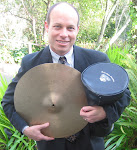Sunday, July 31, 2011
Improving Your Playing: Drumming and Relaxation
The best drummers are relaxed when they play. Watching videos of Steve Gadd and Buddy Rich, you can't help but notice the passion and technique but also the easy, fluid movement. Total relaxation is the goal, and, despite the unlikelihood of absolute relaxation, the goal remains a key element of proper playing.
Relaxation means minimal tightness of muscles involved in drumming--the fingers, hands, wrists, arms, legs, and torso. These parts of the body would feel at ease as you floated on your back under the warm Hawaiian sun, or, less imaginatively, lounging on a comfortable leather chair.
Yet, drumming is a transformation of musical ideas into bodily energy and consumption of calories—not sloth. We hit things, sometimes very hard and very fast. The art takes a lot of physical effort and mental concentration. Our heart rate rises, we perspire, and often become mentally as well as physically exhausted, especially on engagements that require a lot of sight reading, instant creativity, and recorded perfection. If our muscles are tight, usually due to nervousness, they won’t work as well. To demonstrate this to yourself, try gripping the sticks as tight as you can and playing a fast double-stroke roll. Then try doing the same gripping the sticks loosely. Which grip allows you to play with better technique, and which is more fun?
So how does one resolve the opposing forces of keeping relaxed while performing on a physically and mentally demanding instrument? The following techniques have worked for me. My teacher, Greg Sudmeier, taught me many of these.
1. Breathing: in sections of the music that demand less concentration, such as 12 bars of straight jazz time, I monitor my breathing, making sure my breaths are slow and deep, pushing my stomach out as I inhale.
2. Visualization: I visualize the Hawaiian scene mentioned above, feeling my muscles as completely relaxed. Now my muscles won’t become so loose that I drop the sticks, but they will relax considerably.
3. Internal singing: singing the melody helps me internalize the time and like an old friend, puts me on familiar ground, acting as a relaxation device.
4. Hearing the beat as tension and release: I try to hear the music’s pulse as half notes instead of tension-producing 16th notes. I hear in my head a surdo high-low or tension-release pattern. Listen to Brazilian music for examples of the surdo pattern.
5. Lastly, I avoid alcohol and drugs as they may relax the body but dull the mind and always leave side effects, often a rebound of anxiety.
If you found this post helpful, please let me know.
Subscribe to:
Post Comments (Atom)
Teacher by Day, Drummer by Night

Please recommend this blog to others
Popular Posts
-
Many students, grammar school to graduate school, dread writing large papers. However, if you know how to break down the task it becomes alm...
-
BF Skinner Carl Rogers This is a scholarly piece but worth the effort. Please read on... The book, Taking Sides (Noll, 2002) st...
-
I wrote this skit to illustrate how the evolution of art--its form, audience and production have changed. Form, audience, and production ha...





No comments:
Post a Comment